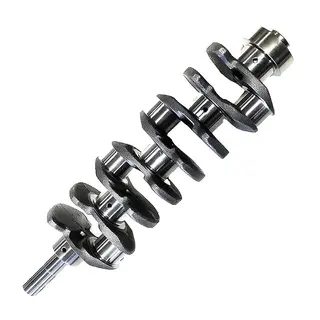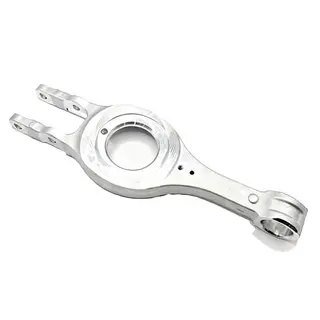In modern industrial manufacturing, large forged steel components are widely used in key fields such as aerospace, shipbuilding, and machinery manufacturing due to their excellent mechanical properties and reliability. The quenching process, as a core link in the heat treatment process, has a decisive impact on the final performance of large forged steel components. This article will explore the quenching process of large forged steel components in depth, detailing every aspect from heating and soaking to cooling, to help readers fully understand this complex and critical process.
Quenching is a heat treatment process in which a metal component is heated to a certain temperature, held for a period of time, and then cooled at an appropriate rate to obtain hardened structures such as martensite or bainite. For large forged steel components, the purpose of quenching is not only to increase hardness and strength, but also to ensure uniform internal structure and reduce the risk of deformation and cracking. This process requires precise control of heating temperature, soaking time, and cooling rate; any mistake in any link may lead to substandard performance or even scrapping of the component.
The heating process is the initial stage of quenching, aimed at uniformly heating the component to the required quenching temperature. The control accuracy at this stage directly affects the subsequent quenching effect and the final performance of the component. Therefore, it is necessary to plan and operate carefully from multiple aspects, including the selection of heat treatment furnace, component loading method, and heating method.
Heating large forged steel components requires the use of furnaces that meet the required standards. These furnaces must have precise temperature control capability and adjustable heating rate to meet the heating requirements of different components. Common heat treatment furnaces include air furnaces and protective atmosphere furnaces. Air furnaces are suitable for most components, while protective atmosphere furnaces are used for components with special surface quality requirements, such as preventing oxidation and decarburization.
Reasonable tooling and loading methods are key to controlling deformation during heat treatment. Components should be placed in the effective heating zone of the quenching furnace to ensure smooth airflow around the inner and outer surfaces and uniform heating. For slender shaft components, it is recommended to place them vertically in the furnace to reduce the risk of bending deformation. The loading temperature should be determined according to the steel grade and the effective thickness of the component. For example, for commonly used 45 and 40Cr steel with an effective thickness ≤600 mm, the loading temperature should be controlled between 400°C and 450°C.
The heating method of large forged steel components generally adopts a stepwise heating approach. This is because large forged components have significant cross-sectional dimensions, which easily produce a large temperature difference between the surface and the core during heating, resulting in high thermal stress. The specific steps of stepwise heating are as follows:
Initial Heating Stage: According to the steel grade and size of the component, select a suitable loading temperature and heat slowly to the elastic-plastic transformation temperature (generally between 600°C and 700°C).
Isothermal Stage: Hold at the elastic-plastic transformation temperature for a period to ensure uniform temperature inside and outside the component.
Final Heating Stage: Heat rapidly to the quenching heating temperature.
The chemical composition of the steel is the main factor determining its quenching heating temperature. The basis for selecting the quenching temperature is the critical transformation point of the steel. In addition, factors such as the material grade, performance requirements, and initial microstructure should be considered. The quenching temperature of large forged steel is generally taken at the upper limit of the corresponding material's quenching temperature to ensure that segregated areas also reach the required quenching temperature and the component is fully austenitized.
After precise heating, the component reaches the required quenching temperature, but this is only the first step toward successful quenching. In the subsequent soaking process, the component needs to be held in the high-temperature furnace for a period to ensure uniform internal temperature and fully prepare for quenching.
Equalizing temperature refers to the process from the component reaching the soaking temperature in the heat treatment furnace to the point when the surface temperature of the component reaches the soaking temperature. The equalizing time for large forged steel components can be estimated based on experience, generally until the surface temperature is uniform and the same as the furnace wall color. Thermocouples can also be installed on the component surface; soaking begins when all thermocouples on the surface reach the quenching temperature.
The purpose of soaking is to make the internal temperature of the component uniformly consistent. The soaking time ultimately depends on achieving a good quenching heating structure in the required area. Soaking time can be determined according to the steel grade and effective thickness of the component:
Carbon steel and low-alloy steel: generally calculated as 0.6 h/100 mm to 1.2 h/100 mm.
Medium-high alloy steel or martensitic stainless steel: generally calculated as 1.0 h/100 mm to 2.0 h/100 mm.
During quenching, it is necessary to ensure the transformation of supercooled austenite to martensite while preventing excessive cooling rates that increase internal stress, causing deformation and cracking. Therefore, an appropriate cooling method should be used to achieve uniform cooling across all surfaces.
The quenching tank should be able to accommodate a sufficient amount of quenching medium to absorb the heat from the component. Auxiliary quenching tanks can be configured, and the flow between the main and auxiliary tanks should meet the quenching requirements. Agitation systems and cooling circulation devices should be installed. Fixtures that allow vertical or horizontal movement of the component during quenching should be provided. For components with complex shapes, auxiliary tooling can be designed according to the component's characteristics.
The quenching cooling of large forged steel components generally uses the following methods:
Air Cooling: Suitable for components with low hardness requirements, slow cooling, low thermal stress.
Mist Cooling: Cooling speed between air and water, suitable for medium hardness requirements.
Oil Cooling: Fast cooling, suitable for high hardness, but with greater thermal stress.
Water Cooling: Fastest cooling, suitable for very high hardness, but with highest thermal stress and deformation risk.
Water–Oil Cooling: First rapid water cooling, then slow oil cooling, combining the advantages of water and oil cooling.
Water–Air Cooling: First rapid water cooling, then natural air cooling.
Water-Soluble Quenching Solution Cooling: Uses a special water-soluble quenching solution, adjustable cooling rate, suitable for components with complex shapes.
In liquid quenching tanks, temperature-sensing elements should display the temperature of the quenching medium, with instrument resolution ≤5°C. During cooling of large forged components, in addition to high thermal stress, significant transformation stress occurs. Excessive internal stress may cause cracks or even fracture, and hinder the transformation from austenite to martensite, delaying or reducing the martensitic transformation.
The quenching cooling time of large forged steel components depends on the final core temperature:
High-alloy steel components: core temperature generally between bainite finish (Bf) and martensite start (Ms), typically 200°C–350°C.
Medium-alloy steel components: core temperature should be below the austenite-to-pearlite transformation temperature, generally 350°C–400°C.
Medium-alloy steel components requiring upper bainite: final core temperature can be higher.
Large forged components with better metallurgical quality: core temperature can be lower than the general cases above.
During quenching, internal stress is generated, including thermal stress and transformation stress. Thermal stress arises from surface-to-core temperature differences, while transformation stress arises from volume expansion during martensitic transformation. Excessive stress can cause deformation, cracking, or even fracture. Methods for controlling stress include:
Selecting suitable quenching media based on component material, effective thickness, and shape. High carbon or alloy content increases the risk of quenching cracks, and the carbon equivalent can be used to evaluate and determine the quenching media and process.
Optimizing cooling rate: choose cooling methods that minimize thermal stress while meeting performance requirements. Computer simulations or trial tests can confirm appropriate methods before production.
Calculating carbon equivalent: If water quenching is desired, calculate the component's carbon equivalent and analyze feasibility based on water quenching data.
Quenching is a key link in the heat treatment process of large forged steel components. By reasonably selecting heat treatment furnaces, designing tooling and loading methods, precisely controlling heating temperature and soaking time, and optimizing cooling methods and rates, the performance of large forged steel components can be effectively improved, and the risk of deformation and cracking reduced. In actual production, computer simulation technology and trial processes should be flexibly used according to the specific component, continuously optimizing the quenching process to meet modern industrial requirements for high-performance and high-reliability large forged steel components.



